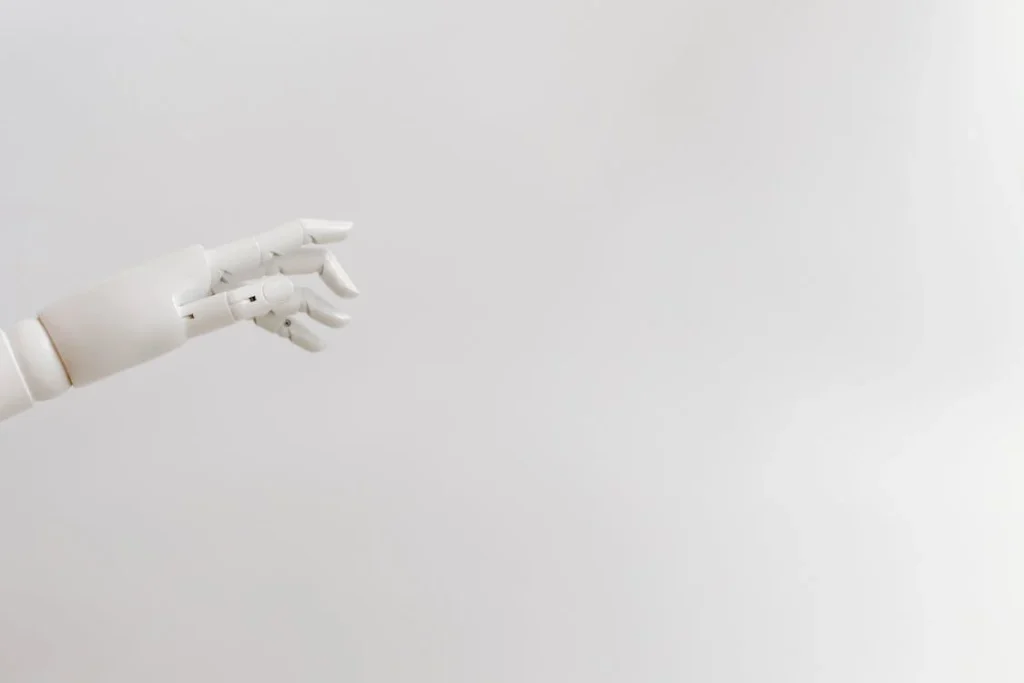Losing a limb is life-changing, but technology is making prosthetics more advanced than ever. In the past, artificial limbs were simple tools meant to replace lost function, but today, they are becoming intelligent extensions of the human body. Thanks to Artificial Intelligence (AI), bionic prosthetics are learning, adapting, and responding in ways that were once unimaginable.
AI is revolutionizing prosthetics by enhancing movement, improving control, and making prosthetic limbs feel more natural. Modern bionic hands and legs can now respond to muscle signals, predict user movements, and even provide sensory feedback. These innovations mean that users don’t just wear prosthetic limbs—they experience them as a part of themselves.
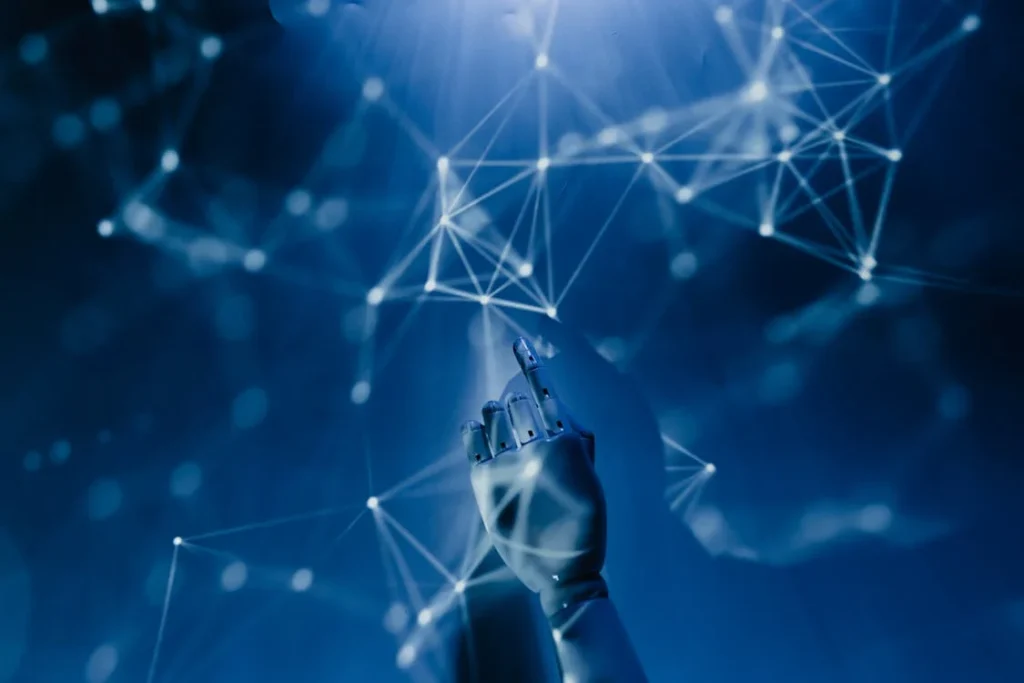
How AI is Transforming Bionic Prosthetics
Traditional prosthetics focused on basic functionality, helping users regain mobility and independence. While these devices were helpful, they lacked the ability to adapt to different situations.
AI is changing that by introducing real-time learning, precision control, and personalized movement patterns.
Better Control Through AI-Driven Muscle Signals
One of the biggest improvements AI brings to bionic prosthetics is better control through myoelectric sensors. These sensors detect electrical signals from muscles in the residual limb and translate them into movements.
While myoelectric prosthetics have been around for years, AI is making them much more precise.
AI-powered prosthetics can now learn from a user’s muscle patterns, improving accuracy and reducing the time it takes to respond.
This means movements feel smoother and more natural. Instead of struggling with delayed responses, users experience fluid and intuitive control, making daily tasks easier.
For example, an AI-enhanced bionic hand can recognize subtle muscle contractions and predict whether a user wants to grip, pinch, or release an object.
Over time, it adapts to individual movement habits, improving efficiency with continued use. This makes actions like picking up a glass of water or tying shoelaces feel much more natural.
Adaptive Learning for Personalized Movements
Every person moves differently, and AI allows bionic prosthetics to adapt to each user’s unique patterns. Instead of relying on fixed pre-programmed motions, AI-driven limbs can learn and improve over time.
This is a game-changer for prosthetic users, as it means their bionic limb becomes more intuitive the longer they use it.
With AI’s ability to analyze movement in real time, prosthetic hands and legs can adjust their responses based on feedback. If a user struggles to grasp an object properly, the AI refines its movements, making future actions more precise.
This level of personalization reduces frustration and improves overall functionality.
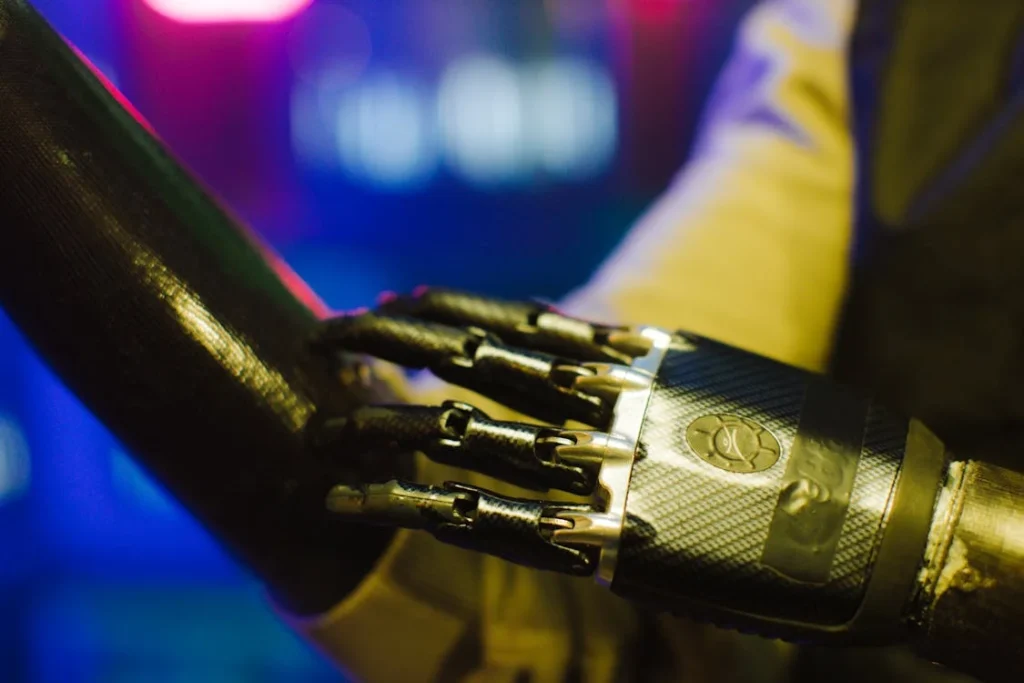
Restoring Sensation: AI and the Future of Touch in Bionic Prosthetics
One of the biggest challenges in prosthetic technology has always been the lack of sensory feedback. Traditional prosthetic limbs allow users to perform movements, but they don’t provide the feeling of touch, pressure, or texture.
This makes it difficult to judge how much force to apply when holding an object, leading to accidental drops or excessive pressure. AI is helping to change this by bringing haptic feedback and sensory restoration to bionic limbs.
How AI Helps Prosthetic Limbs “Feel”
AI-powered prosthetics use advanced sensors and neural interfaces to give users a sense of touch. These sensors are placed in the fingers or palm of a bionic hand and detect pressure, temperature, or vibrations.
AI then processes this information and sends it to the nervous system, allowing users to experience touch in a way that feels natural.
For example, when someone using a bionic hand touches a soft surface, pressure sensors measure the force applied. AI then translates this data into electrical signals that are sent to the brain, creating the sensation of touch.
This allows users to feel whether an object is hard or soft, rough or smooth, and adjust their grip accordingly.
Some AI-driven prosthetics also use pattern recognition to distinguish different textures. This means users can tell the difference between holding a smooth glass or a rough sponge, something that was previously impossible with traditional prosthetic technology.
Brain-Machine Interfaces: The Next Step in AI Prosthetics
A major breakthrough in AI prosthetics is the development of brain-machine interfaces (BMIs). These systems allow prosthetic limbs to communicate directly with the brain, eliminating the need for external muscle control.
Instead of moving a prosthetic hand using residual limb muscles, users can simply think about a movement, and AI translates that thought into action.
BMIs work by placing tiny electrodes on the brain or nerves to detect neural signals. AI interprets these signals and converts them into precise movements in the prosthetic limb.
This technology is still in its early stages, but researchers have already demonstrated its potential in allowing completely paralyzed individuals to control robotic arms using only their thoughts.
With further advancements, BMIs could make prosthetic limbs almost indistinguishable from biological ones, giving users full control and sensory feedback.
This would mean a person could pick up a delicate object without even thinking about how to do it—the prosthetic would move just like a real hand, responding instantly and naturally.
The Emotional and Psychological Impact of AI in Prosthetics
Beyond physical improvements, AI-driven prosthetics have a profound emotional impact on users. The ability to feel touch, move naturally, and interact with the world as they once did before amputation restores confidence and independence.
Many users report that AI-powered prosthetics feel more like a part of them rather than just a tool, reducing the emotional challenges of limb loss.
At Robobionics, we believe in creating prosthetic solutions that not only restore function but also improve quality of life. Our innovative bionic hand, Grippy™, is designed to integrate seamlessly into daily life, offering a balance of advanced AI control and ease of use.
As AI technology continues to evolve, the future of bionic prosthetics will only get smarter, more intuitive, and more human-like.
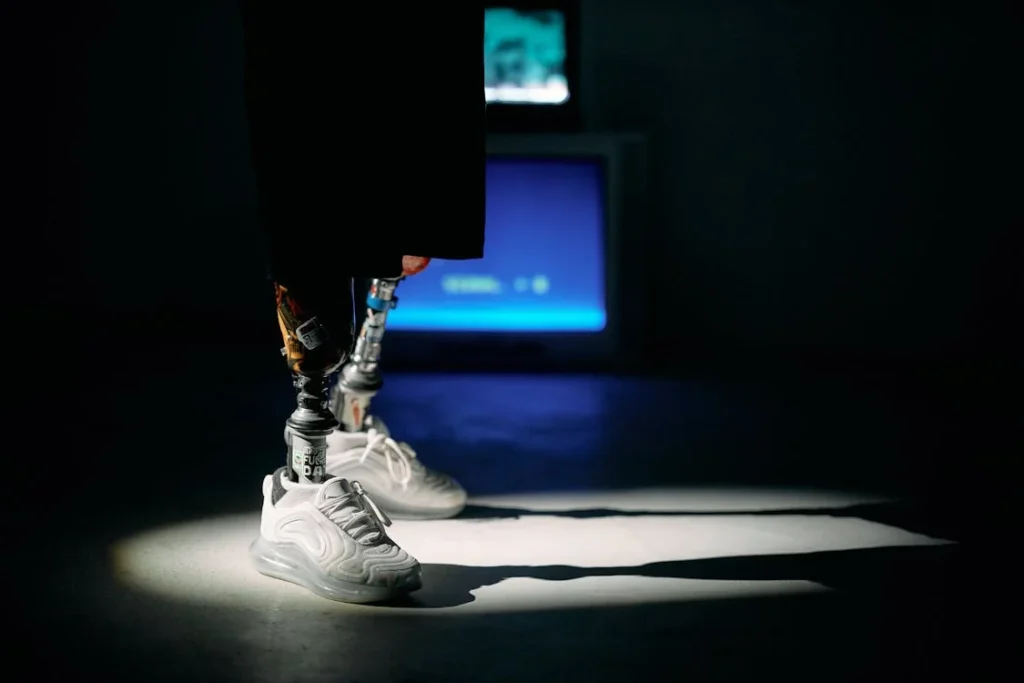
AI and Motion Prediction: Making Bionic Limbs More Natural
One of the most exciting advancements in AI-driven prosthetics is motion prediction. Traditional prosthetics require deliberate effort to move, which can make actions feel slow or unnatural. AI is changing this by allowing bionic limbs to anticipate movements before they happen.
This creates a seamless and intuitive experience, where the prosthetic responds almost as quickly as a natural limb.
How AI Predicts Movement
AI-powered prosthetics use advanced algorithms that analyze muscle signals and movement patterns. These algorithms learn from repeated actions, allowing the prosthetic to recognize movement intentions before the user fully completes them.
Over time, the AI refines its predictions, reducing the delay between thought and action.
For example, if a person frequently picks up a coffee cup in the morning, the AI learns the specific muscle patterns associated with that action.
Eventually, the prosthetic can predict the motion and adjust the grip in real time. This eliminates the awkwardness that sometimes comes with early prosthetic use and makes everyday tasks feel natural.
AI-driven motion prediction also enhances walking for those using bionic legs. The system adapts to different terrains by recognizing walking patterns and adjusting the prosthetic’s response.
Whether stepping on uneven ground or climbing stairs, the AI helps ensure stability and reduces the risk of falls.
Reducing Mental Effort for Prosthetic Users
Using a prosthetic limb can sometimes require intense focus, especially when learning to control it. AI minimizes this mental effort by automating small adjustments in movement.
Instead of having to think through every step, users can move naturally, just as they would with a biological limb.
This improvement is particularly helpful in multi-tasking situations.
A person using a bionic hand can type on a keyboard while holding a phone without having to consciously switch focus between each action. The AI manages the fine details, making life easier and reducing frustration.
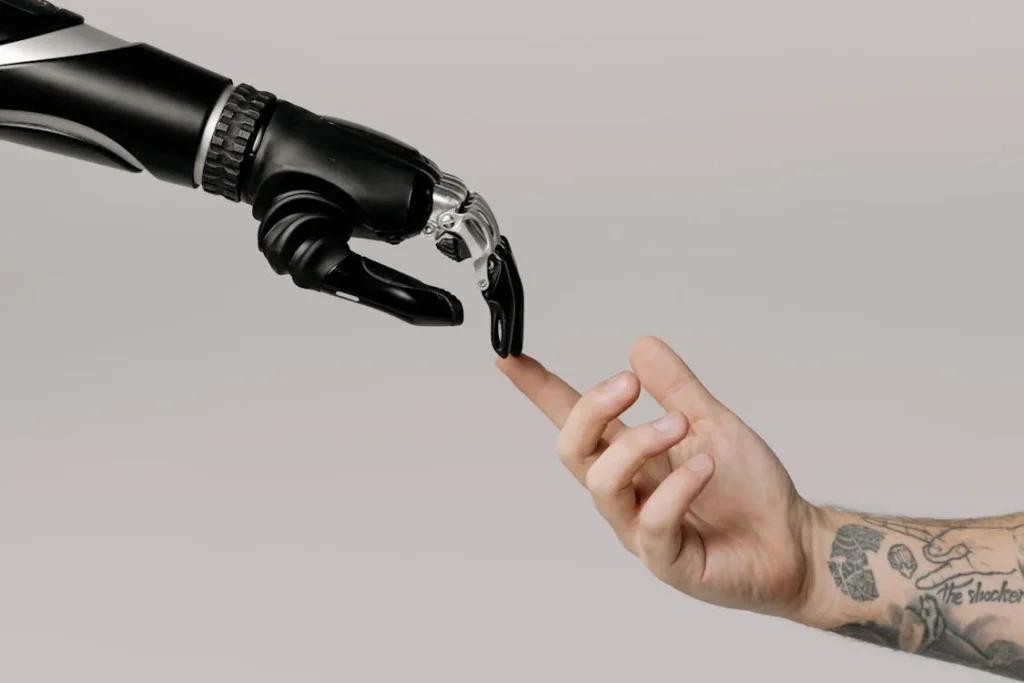
AI in Prosthetics: Enhancing Speed, Accuracy, and Adaptability
The integration of AI in prosthetics is transforming the way users interact with their artificial limbs. One of the key breakthroughs is the improvement in speed, accuracy, and adaptability, making movements more fluid and natural.
Traditional prosthetic limbs often feel slow and rigid because they rely on manual control. AI eliminates these limitations by allowing the prosthetic to respond almost instantly to the user’s intentions.
Speed and Real-Time Adaptation
AI-driven prosthetics process muscle signals and neural inputs at an incredible speed. Unlike older prosthetic models that require conscious effort to move and adjust, AI-enhanced limbs react in real-time, mirroring the response time of a biological limb.
This quick reaction time is crucial for performing tasks that require split-second decisions, such as catching an object before it falls or adjusting grip strength based on the weight of an item.
Real-time adaptation also improves walking and balance in users with bionic legs. AI can analyze walking patterns and adjust movements within milliseconds, ensuring a smooth and stable gait.
Whether walking on grass, climbing stairs, or stepping over obstacles, the prosthetic automatically adapts to different surfaces without requiring manual adjustments.
This level of responsiveness reduces strain and makes walking feel more natural, allowing users to focus on their surroundings rather than their prosthetic.
Improved Accuracy and Precision
AI in prosthetic limbs enables a level of precision that was previously impossible. Myoelectric sensors in the prosthetic detect electrical signals from the user’s muscles, but AI refines these signals to ensure accuracy.
Without AI, muscle signals can sometimes be misinterpreted, leading to unintentional movements or difficulty controlling the prosthetic. AI algorithms filter out unnecessary noise, ensuring that only intentional movements are executed.
For example, when grasping a fragile object like a glass or an egg, AI-powered bionic hands can adjust grip pressure in real-time, preventing accidental breakage.
The prosthetic recognizes the amount of force needed and applies just the right amount of pressure. This accuracy is essential for delicate tasks such as buttoning a shirt, writing with a pen, or using a touchscreen device.
Personalized Learning and Long-Term Adaptability
One of the most groundbreaking aspects of AI-driven prosthetics is their ability to learn from each user’s unique movement patterns. No two individuals move the same way, and AI ensures that the prosthetic adapts to each person’s habits and needs.
The more a person uses their prosthetic, the smarter it becomes, refining movements for better efficiency over time.
AI can also adjust to changes in a user’s strength, posture, or activity level. If a user’s muscles become stronger or weaker over time, the prosthetic fine-tunes its response to match the new conditions.
This adaptability makes AI-powered prosthetics a long-term solution, reducing the need for frequent manual recalibrations.
Robobionics is at the forefront of this technology, ensuring that our bionic solutions, like Grippy™, incorporate cutting-edge AI for faster, more natural movement.
As AI continues to evolve, prosthetic limbs will only become more advanced, offering users an experience that feels increasingly like having a real limb.
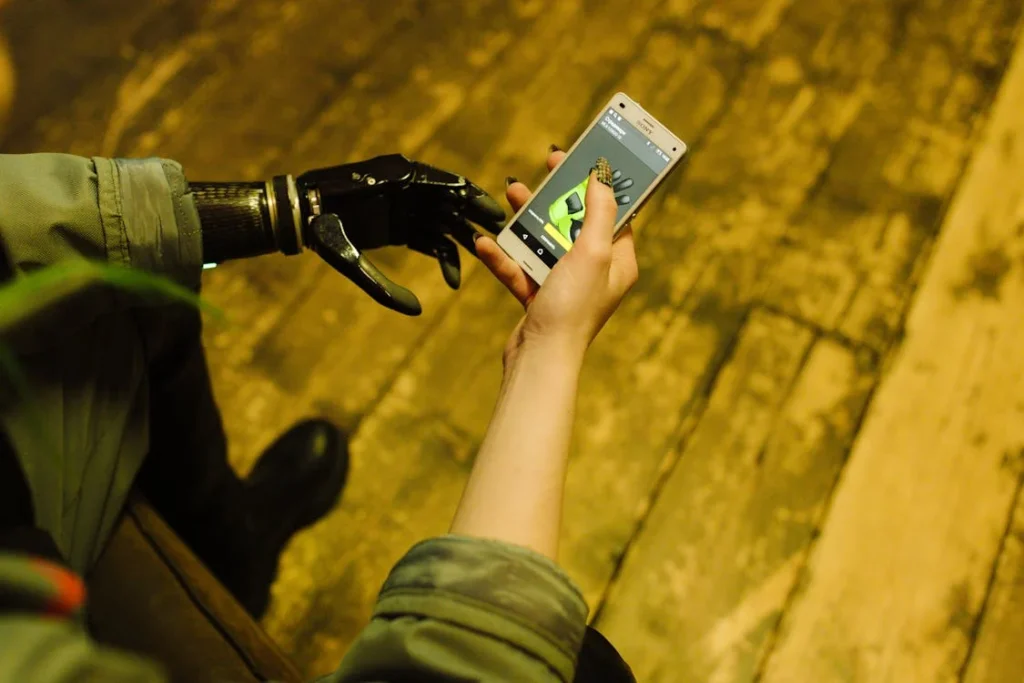
AI and the Future of Fully Integrated Prosthetics
The goal of AI in prosthetics is not just to improve function but to create a seamless integration between the human body and artificial limbs.
The future of prosthetic technology is moving toward complete synchronization, where users no longer have to think about their prosthetic as a separate tool but as a natural part of their body.
This is being achieved through advancements in neural integration, machine learning, and biofeedback systems that allow for deeper communication between the brain, nerves, and prosthetic limb.
Neural Integration and Direct Brain Communication
One of the most promising developments in AI prosthetics is the ability to connect directly to the nervous system.
Instead of relying solely on muscle signals, researchers are working on ways to link bionic limbs directly to the brain through neural implants or non-invasive brainwave detection.
This allows for faster and more accurate movement, as the prosthetic receives commands in the same way a natural limb would. Users can think about a movement, and the prosthetic executes it almost instantly.
AI plays a critical role in processing the brain’s signals, filtering out noise, and ensuring the correct movement is carried out. Because each person’s nervous system is unique, AI adapts to individual neural patterns, making the prosthetic more intuitive over time.
This kind of brain-prosthetic communication is already being tested in research labs, and as the technology improves, it could lead to a future where prosthetic limbs feel as natural as biological ones.
Machine Learning and Continuous Improvement
AI-powered prosthetics are designed to evolve with their users. Through machine learning, these prosthetic limbs analyze patterns of movement and adjust accordingly.
Unlike traditional prosthetics, which function the same way every time, AI-enhanced limbs improve the more they are used. This means that over time, movements become smoother, more precise, and better suited to the user’s needs.
For instance, if a user struggles with a specific motion, such as grasping a small object, the AI recognizes the difficulty and refines its approach.
By continuously learning from past movements, the prosthetic adjusts its grip strength, wrist rotation, or finger positioning to make the action easier.
This eliminates the need for constant recalibration and allows users to naturally develop a sense of confidence in their prosthetic’s abilities.
Biofeedback and the Sense of Touch
The next major leap in AI prosthetics is biofeedback, which restores the sensation of touch to users who have lost it. Current research focuses on integrating sensory feedback systems that allow prosthetic users to feel texture, temperature, and pressure.
This is done through advanced AI algorithms that interpret sensory data from the prosthetic and send it back to the nervous system.
With AI-driven biofeedback, users will no longer have to guess how firmly they are holding something. They will be able to feel how tightly they are gripping a cup, sense the difference between rough and smooth surfaces, and even detect slight temperature changes.
This creates a more immersive and natural experience, making the prosthetic feel like an extension of the body rather than a separate device.
At Robobionics, we are dedicated to advancing AI-driven prosthetic solutions that enhance both function and quality of life. As the field of AI continues to grow, the dream of fully integrated, smart prosthetics is becoming a reality.
The future holds the promise of bionic limbs that not only move like natural limbs but also feel and respond in ways that were once thought impossible.
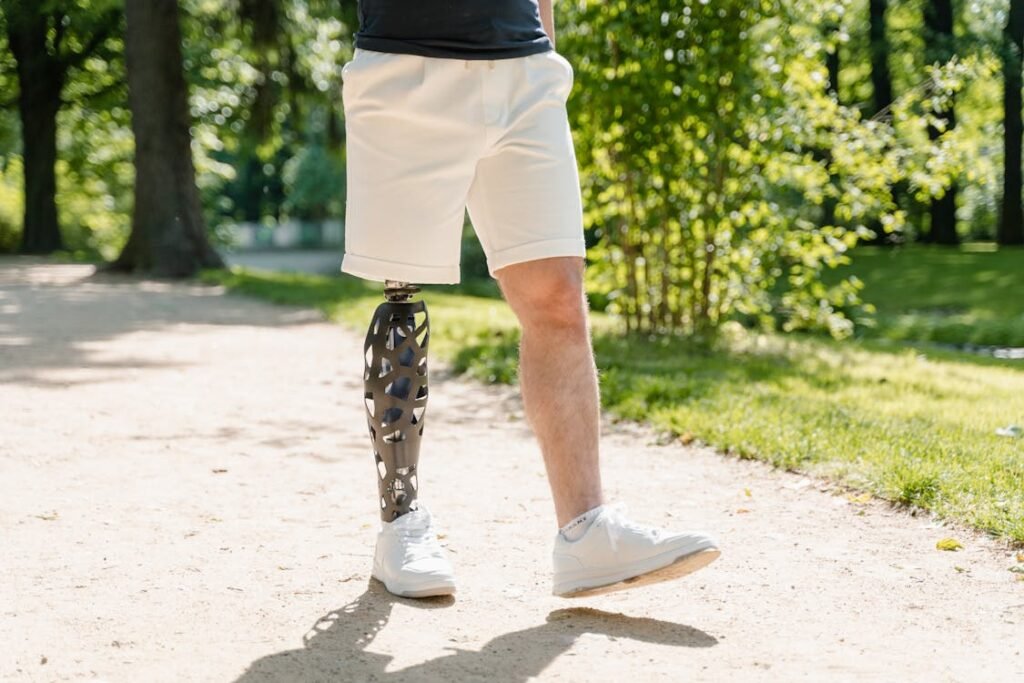
AI-Driven Prosthetics and Everyday Life: Real-World Benefits
The advancements in AI-driven prosthetics are not just theoretical; they are already making a huge difference in the lives of users.
From performing basic daily tasks to participating in sports and creative activities, modern prosthetics are enabling people to regain their independence in ways that were once unimaginable.
AI is making bionic limbs more intuitive, responsive, and adaptable to real-world situations, ensuring that users experience a higher level of ease and confidence in their everyday lives.
Seamless Interaction with the Environment
One of the biggest advantages of AI-powered prosthetics is their ability to adjust automatically to different environments. A bionic hand equipped with AI can recognize when the user is reaching for a fragile object and adjust its grip accordingly.
Similarly, a bionic leg can detect changes in terrain and modify its walking pattern in real time. This level of adaptability reduces the effort required to operate a prosthetic and allows users to move through the world with more freedom and confidence.
In social settings, AI prosthetics improve interactions by enabling natural movements and gestures. Shaking hands, waving, or holding onto objects no longer feels mechanical or awkward.
The AI continuously refines these motions, ensuring that movements appear fluid and effortless. This not only improves physical function but also enhances emotional well-being by making social interactions feel more natural.
Enhancing Work and Creative Activities
For many users, regaining the ability to work is one of the most significant benefits of AI-driven prosthetics. Whether it’s typing on a keyboard, using tools, or handling small objects, AI-powered hands offer the dexterity and precision required for various professions.
Because these prosthetics adapt to individual movement patterns, users can complete tasks with greater efficiency and less fatigue.
Beyond work, AI prosthetics are also opening doors for creativity. Musicians, artists, and athletes who have lost limbs are now able to continue pursuing their passions thanks to responsive and intelligent prosthetic technology.
A bionic hand can be programmed to play an instrument with precise finger movements, while a bionic leg can adjust to the impact and motion needed for sports. AI allows for customization, making it possible for users to fine-tune their prosthetics for specific activities and skills.
Improving Quality of Life and Reducing Fatigue
One of the lesser-discussed but incredibly important aspects of AI-driven prosthetics is how they reduce physical and mental fatigue.
Traditional prosthetic limbs often require a great deal of concentration and effort to operate, which can be exhausting over long periods. AI simplifies this process by automating certain movements and learning from past actions.
For example, if a user frequently performs a particular task, such as gripping a fork or opening a door, the prosthetic recognizes the pattern and refines the movement for efficiency.
This reduces the strain on the user, making daily life feel more natural and less tiring. AI also minimizes the number of corrections needed when performing tasks, meaning users spend less time adjusting their prosthetic and more time focusing on what matters most to them.
Robobionics continues to push the boundaries of AI-driven prosthetic technology, ensuring that users experience not just functionality, but true integration into their daily lives.
The goal is to make bionic limbs as seamless, intuitive, and empowering as possible, giving individuals the confidence to live life without limitations.
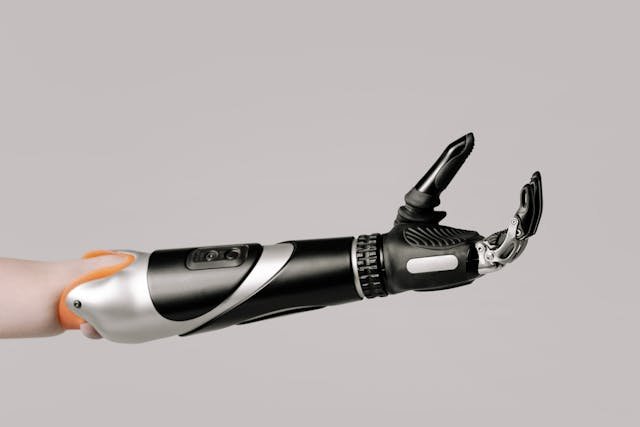
The Future of AI in Prosthetics: What Lies Ahead?
As AI technology continues to evolve, the future of bionic prosthetics looks incredibly promising.
Researchers and engineers are constantly developing new ways to improve the connection between artificial limbs and the human body, making them more responsive, intelligent, and personalized.
The coming years will likely bring even more advanced AI-driven prosthetics that will further blur the line between human and machine.
Smarter AI for More Intuitive Control
One of the biggest areas of advancement is in refining AI algorithms to make prosthetics even more intuitive.
Current AI prosthetics already learn from user behavior, but future versions will likely have enhanced predictive capabilities, allowing them to respond even faster and more accurately.
Instead of simply recognizing muscle signals, AI will analyze subtle shifts in nerve activity, brain waves, and even body posture to anticipate movements before they happen.
For example, a next-generation AI prosthetic hand could sense micro-movements in the user’s arm and wrist, predicting their intended action before they fully engage their muscles.
This would eliminate any delay between thought and movement, making the prosthetic feel completely natural.
AI will also become better at adapting to changes in the user’s body over time, automatically recalibrating as muscle strength shifts or as the user refines their movement patterns.
AI and the Connection to the Nervous System
A major breakthrough on the horizon is the direct integration of AI-powered prosthetics with the nervous system. Researchers are working on brain-computer interfaces (BCIs) that allow bionic limbs to communicate directly with the brain, bypassing the need for muscle signals.
This means that users could simply think about moving their prosthetic, and it would respond instantly, just like a natural limb.
Neural implants and AI-driven signal processing will play a key role in making this technology a reality. These implants would pick up electrical activity in the brain, process it using AI, and translate it into precise prosthetic movements.
While this technology is still in its early stages, early trials have shown promising results, with test subjects able to control robotic limbs using their thoughts alone.
Self-Repairing and Adaptive Prosthetic Limbs
AI may also lead to prosthetic limbs that can self-repair and adapt to damage. Future bionic hands and legs could be designed with self-healing materials that use AI to detect wear and tear, triggering automatic repairs when necessary.
This would greatly reduce maintenance costs and extend the lifespan of prosthetic devices, ensuring they remain in peak condition for longer.
Additionally, prosthetic limbs could become even more personalized by automatically adjusting to the user’s daily activities.
If a user frequently performs certain actions—such as playing an instrument or lifting heavy objects—the AI would optimize the prosthetic’s responses for those specific activities, fine-tuning movement and grip strength accordingly.
Making AI-Driven Prosthetics More Accessible
One of the key challenges in prosthetic technology today is affordability and accessibility. Many advanced AI-driven prosthetics remain expensive and out of reach for many individuals who need them.
However, as AI technology becomes more widespread, costs are expected to decrease, making high-quality prosthetics more affordable.
Innovations in 3D printing, open-source AI software, and modular designs will further contribute to reducing costs, allowing more people to benefit from cutting-edge prosthetic solutions.
At Robobionics, we are committed to ensuring that AI-powered prosthetics are not just a luxury for a few but a practical, affordable solution for many.
Our focus is on making advanced bionic limbs available to as many users as possible, ensuring that everyone who needs a prosthetic can access the latest technology without financial barriers.
As we look to the future, AI will continue to drive innovation in prosthetic design, making artificial limbs smarter, more responsive, and more lifelike than ever before.
The ultimate goal is to create bionic limbs that feel like an extension of the body, restoring not just movement but also the sense of touch, confidence, and independence to users worldwide.
Conclusion
The integration of AI in bionic prosthetics is revolutionizing the way individuals experience life after limb loss. What once seemed like science fiction is now becoming reality, with prosthetic limbs that can predict movements, restore sensation, and seamlessly adapt to the user’s needs. AI-driven prosthetics are not just restoring function; they are enhancing human potential, offering users a level of independence, control, and confidence that was previously unimaginable.
With advancements in neural integration, machine learning, and real-time adaptability, the future of AI-powered prosthetics is bright. The dream of prosthetic limbs that move and feel like natural ones is closer than ever, and as technology continues to evolve, we can expect even greater breakthroughs. From direct brain-computer interfaces to self-healing materials, AI is paving the way for smarter, more intuitive prosthetics that will change lives for the better.
At Robobionics, we are committed to leading this transformation. Our mission is to ensure that cutting-edge AI prosthetic solutions are accessible, affordable, and life-changing. Whether you’re looking for an advanced bionic hand like Grippy™ or exploring the possibilities of AI-driven rehabilitation, we are here to help. The future of prosthetics is here—smarter, stronger, and more human than ever.
If you’re ready to experience the next generation of prosthetics, reach out to Robobionics today for a free consultation. Your journey toward a more independent and empowered life starts now.



